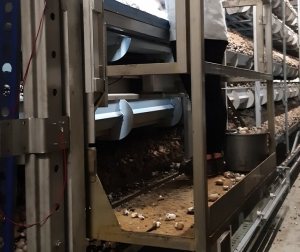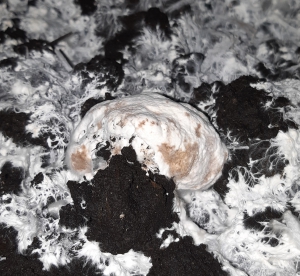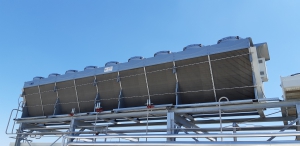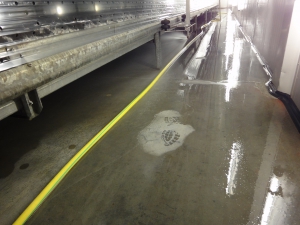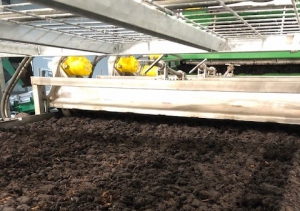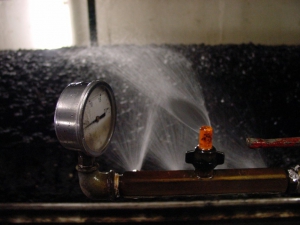And now for something completely different
The corona crisis makes traveling for a consultant difficult, if not impossible. That is why the question asked by Marco Deckers came just in time.
Henk, we are looking at picking on a different angle on our farm. GTL Europe is building my new farm with the tilting shelf system and we are creating a sparring team to start this up.
Now, that’s what I call a challenge.
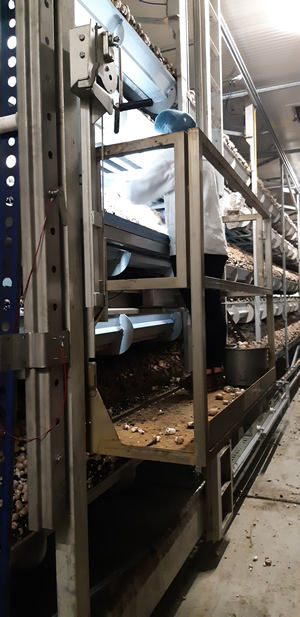 The system is so completely different that picking has to be re-designed.
The system is so completely different that picking has to be re-designed.
The pickers are not standing sideways to the shelf but they are facing it and they have to learn to pick with two hands at the same time.
At the same moment we have to get them on a level where they can work in a high tech environment where they have to keep an eye on moving belts, tilting shelves and moving trollies. And yes, they also have to learn how to pick mushrooms at a good speed.
The first thing we did was to create a good team of new pickers and new supervisors. Because also in supervising the job is different. It is very simple to control quality and size of mushrooms because every mushroom you see coming out of the room on the conveyor belt has just been picked. So corrections on size or quality can be made immediately. You do not have to wait for the first trays of mushrooms to come out of the room. So supervising is easier. The biggest change for the supervisor in this case is more in the logistic and technical areas.
For the pickers the change is bigger.
Picking with two hands sounds nice but everyone is either right- or left handed. Only few people are double handed in their natural movement. This means that every picker has a preference to pick most mushrooms with one hand and a few in the other hand.
But this was actually easier to learn than expected. One thing that helps is the picking position. The height can per perfect so the picker does not have to bend the lower back or overstretch arms. It was simply a trick the had to learn. A mind set to position the arms that way as if it is one movement. The one thing they had to learn was to pick within eyesight and keep the arms together.
All together it is surprising to see that most of the pickers like the system a lot. Picking is fast and at the end of the day nobody is complaining about neck or shoulder problems. The usual complaints of a picker after a long day of picking. It has to be said though that the picker has to be told to put the platform at the right position. Pickers all over the world are a bit stubborn and if it is nearly right, for them it is okay. But it may not be the perfect position.
Looking back now we can draw a few conclusions.
It is better to start with pickers who have no experience in picking.
The supervisor is the main person in the team. Even more than in a traditional system. There is more technique involved and the supervisor needs to see possible problems fast and solve them
People have no problems with the environment full of moving parts. Even the opposite, they like it because it makes the work easier.
Training is essential. That is why at the moment we are writing a manual for that system on that particular farm. And again, in the training the supervisor (picking manager) is the key person.
And as a consultant you have to keep an open mind about the system and the way of picking. From the start till now you can say we started with system 2.0. Now we are already operating on system 5.0. It is evolving and growing in an exciting way. That is the benefit of having a good sparring team with the farm managemant, building company, picking staff and consultant.
Mycogone: easy come, easy?
Mycogone or wet bubble is making its appearance again on many farms. Growers are looking for all different chemical solutions and are gearing up hygiene measures. Most of the times too late. Because chemicals also do a lot of damage to the crop and the schedule often is simply too short to give the right effect.
And as for gearing up hygienic measures, one real big grower once said to me:
If I have no disease I am really worried because nobody is paying attention anymore to hygiene. If on the other hand I dó have a disease everyone is doing what the can.
For Mycogone it is important to look at the origin and take that away. It is a fungus growing in soil, sand or rotting materials. That is why many growers point at the casing soil. Not really correct because it does not grow in deep dug peat because the ph is too low. But casing soil polluted with sand will be infected so it is better to look at transport, the act of casing the room and the circumstances around that.
The spores of Mycogone are not airborne by themselves. The need a vector of taxi. In most of the cases this is dust, animals, people or insects. Especially dust is a factor that is hard to control.
The moving of soil in the vicinity of the room that you are filling is a guarantee for infection. So is the harvesting of agricultural crops near the farm if the wind is blowing the dust to your farm.
So keeping the room that you are filling and the casing soil out of the wind to avoid dust is already a good thing. So is cleaning of the trucks before they enter the filling area. And flushing with plenty of water may be more effective than using a disinfectant.
At the same time keep the whole area wet so dust cannot fly around.
For growers who use casing soil in plastic bags, do not bring them into the room or wash them before use. Plastic is electro static and attracts dust.
It is a myth by the way that Mycogone comes in with the compost. It cannot grow in phase 3 compost.
The following point is people. If the filling team walks through grass or sand during filling, again that is a major failure. So is not wearing clean clothes at the moment of filing. Also do not let the filing team have their coffee break in the same canteen used by the pickers. When they return to the job they may be covered in spores.
A thing harder to control is insects. If you have an infection of sciarids or phorids on the farm an outbreak of bubble is likely to happen. But one of the next blogs will be about these creatures.
One general remark: keep the farm and the vicinity clean at all times. Free from rests of casing and compost but also free from paper, cardboard and other mess. This will help to fight all types of disease.
And then it's summer!
Europe is now at the time of the year summer will burst out. And every year the same growing problems occur at this time, getting worse and worse every year. Summers seem to get hotter and it is time to adapt before real growing problems are there. There are a number of things growers can do but of course a good cooling system is a must. Well calculated, fitting the circumstances of your own country. But even the best cooling system will not cover everything. If we take the summer temperature last year in Holland at 42° nobody has a cooling system which will handle these extreme temperatures in our country.
If at the same moment also the relative humidity is high it is not only cooling but also the heating that counts. And that brings me to the first mistake many growers make. In summer switch of the heating system. Its hot enough outside, I do not need heating. Wrong!!!
De-humidification only works if the cooling can work in combination with a bit of heating. So, by switching of the heating the system can make the air dryer anymore. And you need dry air to cool a hot room. The easiest way to cool a growing room is to give water to the casing soil. The best way is to give many small quantities up to 2 litres. That can be evaporated again. Spread the watering over 24 hours. The dry air coming into the room will take care of the evaporation and will help cooling the growing room. Keep the casing soil wet but the floor as dry as possible. That is why I do not close the room completely if the outside is hot but dry. It is possible to use air which is much higher than the compost temperature as long as the incoming air is dryer than the air in the room.
In the mollier diagram one can calculate how much fresh air is necessary to absorb the evaporated water in the room. And for that cooling by evaporation you only need a few litres of water extra. No extravagant quantities as some growers tend to do. An extra help will be some mobile coolers on the farm. They can be placed into the room just before the heat surge is starting. The price of such a mobile cooler is a lot lower than the costs of losing a room.But in the end, judging a room is important. If compost is active and the C/N ration is relatively high one can expect activity. It is of outmost importance that cooling starts before the surge starts. Once a compost is going up it is hard or impossible to stop it.
Floor humidity and the effects
Floor humidity
If you want to maintain a natural climate in the growing room during the recovery period until about five days after ventilation you should water the floor and walls of the growing room. Do this at intervals of between one and six hours. You will notice the result as a shock effect in the graph displaying the RH and growing room temperature. I will explain what is actually happening and how to avoid a shock effect.
The effects of floor humidity
If you stand in the growing room while the watering system is wetting the floors and walls you will see several things happening. The watering system contains nozzles which moisten the floors and walls with water droplets and it also creates tiny, airborne droplets of water. If you shine a torch you will see the little water droplets floating in the air. Eventually the droplets fall onto the beds and the sensors of the climate computer. This has two disadvantages:
1. Climate disruption
The water droplets which fall on the sensors are cold. They disrupt the climate, which causes a response from the computer. The effect is minimal but your aim is to keep the climate as constant as possible. This uses the least energy.
2. Abnormalities
The water droplets fall on the beds where the mycelium is recovering. These water droplets disrupt pinning, resulting in cluster-shaped abnormalities which develop before the first flush.
How can you prevent this?
Make sure that there is sufficient water pressure (see photo) while the floors and walls are being wetted. In this way you prevent the droplets from floating in the air. In addition, make sure that the whole floor is wet. This approach means that the floors dry out less quickly, ensuring that the climate in the growing room is more uniform and favourable for growth.
Mark den Ouden
Next courses:
Live training Mushroom Signals Essentials: 12 – 16 October 2020
The e-learning course offers the theorical knowledge of the Mushroom Signals book that is necessary for the live training sessions. During live training, all participants have the same basic knowledge, so there is plenty of time to deal with individual questions. This is not only valuable for the participant but sharing knowledge between the trainer and the other participants makes the theory more relevant. The everyday practice at the composting facility and the mushroom farm of the participants will also be discussed.
Other courses in 2020: 30 November – 4 December 2020.
Always available:
E-course Mushroom Signals Essentials
More info about the course see www.mushroomoffice.com
Importance of filling
Many times when I see growing operations I got questions on how to get improvements and many times it always comes back to the way the room is filled. When at filling there is not enough knowledge or attention to details it will affect the rest of the growing cycle. Lets highlight some of those details.
The amount of caccing is very important to get an even growth of the mycelium into all the room but is not so easy as it sounds. Only when the compost layer comes perfectly even out of the head filling machine before the casing falls on top it is possible to get the job done with the first spinner on the machine, the spinner that is used to get caccing in the casing and spread the casing evenly. In many occasions I don’t see the even compost layer and therefore we have to go back to the other side of the machine to see what is causing the problem. It can be an uneven supply of the compost, the swivel belt timing or not enough and uneven compression. Makes sure to solve that before setting the caccing depth. Also, make sure to get an even amount of supply into the casing hopper, if not too much casing will get pushed through on moments cause more casing on those spots, so an uneven caccing there. Depending on the structure of the casing and the desired structure you can adjust the speed of the spinner to get the right result.
After the first spinner there is the next spinner with the purpose of leveling the casing. Depending on the structure of the casing adjust the speed again and make sure to set the spinner not too deep. When that spinner goes to deep and there will built up more casing behind the spinner what will happen is that it will throw casing over the spinner causing an uneven casing layer. The casing layer should have the right and even level required after the spinner before it goes under the press at the end.
Use the press for the final touch, press the casing slightly at the end of the machine, just enough to push down the last loose casing on the top but not so much that it causes anaerobic spots on top. If the level is not good enough with the 2nd spinner, the press will press too much casing and just causing anaerobic spots of casing on top of the beds where no mycelium will grow in. Minimize that as much as possible.
Setting the machine in the morning is very important. I would always start the machine on the 2nd shelf, set it up as required and try not to change too much during the rest of the room. The most critical in that is to set the right compost height in the morning to avoid too many changes. Of course we always need to adjust if necessary but make sure then to minimize the changes and if you have to adjust, adjust all the settings. A change of compost height might change the compost press, height of the spinners and casing press roll. In practice that gets forgotten and causing a different fill after the compost height is changed.
A good filling is a head start of every growing room. I just highlighted a few details that need attention but there are many more of course. It’s not so easy to get the room filled exactly as required but good training and of course good equipment will get the job done and make the rest of the cycle easier to get the maximum result.
Erik de Groot
This email address is being protected from spambots. You need JavaScript enabled to view it.
Water, the ongoing discussion
If one wants to start a discussion with a grower (or with a consultant), start talking about watering.
How much, when and what watering method.
To make any sense though, you first have to define the period. There is watering on casing soil and watering over mushrooms and between flushes.
This blog is about watering on the casing soil during the incubation period. The water given in that period is to bring the casing soil up to the maximum moisture level and to keep the compost at the right moisture.
A good phase 3 compost at the moment of casing will be around 60% in moisture. For white strains that can be up to 3% higher, brown strains prefer 1 or 2% drier. It is not possible to bring the compost to a much higher moisture level by watering it after filling. It is possible to give water into the compost but that will be free water which has to disappear during the fructification period.
2 up to 4 litres of water can be given into the compost at filling or later but that should be the maximum. Even if it is necessary to cool the compost. This can better be done by giving water into the casing and let it evaporate with fresh air and circulation.
Casing soil itself can handle up to 7 litres per m² plus the water that was originally in the casing. To be sure, we talk about a casing containing white and black peat.
More than 7 litres will evaporate, go into the compost or down the drain.
Considering that the evaporation can be around 2 litres per m² per day, the loss with evaporation is about 10 litres. If you count the loss of dripping, the water staying in the compost and the evaporation you come to a figure of about 25 litres of water. In practical situations this means a total amount of water between 20 and 30 litres average. Depending on the farm and the time of the year. Growing drier often means a loss of production and growing a lot wetter means problems in growing, mainly in the outgrow of mushrooms.
Another thing to watch for is the watering method. Make sure that the pressure of the water onto the casing is not too high. Too many times I see a casing with a damaged surface which will give problems in the evaporation.
Every system has a different pressure and if you are not sure, ask the manufacturer. Regularly cleaning of the nozzles is something will help maintaining the right pressure and the right adjustment of the watering trees, looking at distance and height according to the casing level.
Keep watering but do not take it over the top!!












